|

|
BREEDS & their NEEDS
ROSEATE COCKATOO
better known as
the GALAH |
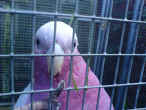
|
|
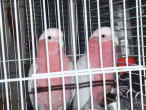
|
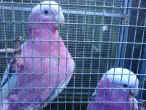
|
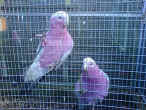
|
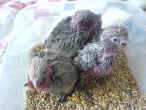
|
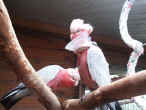
|
Pinky
& Perky @ 2yrs
They are parents to Red & Chippy
|
Red
& Chippy 6 months
Note the grey in the pink breast plumage - a sign of a jeuvenile. |
Red
& Chippy 6 months |
4
Galah chicks
28 - 32 days old |
Breeding
pair
Hen had injury to Keel - collar is to stop her chewing & let it heal. |
Info on the Breed:
- The originate from Australia.
- Here the Farmers have been known to shoot them becos
they regard them as a menace.
- They can strip a field, of it's grain crop in a
short period of time esp. if the flock is big enough!
- They are a very sociable bird and tend to congregate
in flocks esp. at roosting time (in the wild).
- Even at breeding time they are quite happy to nest
in close proximity to another pair so long as their "space" is not
invaded.
- They are one of the Clowns of the Bird world.
- They have a reputation of not being very intelligent
- hence the insultive saying in Australia to
someone who is acting a bit
"thick" - "You great gallumping Galah"!!
- They are however, just very amenable and fairly
"easy-going".
- They accept changes in their Aviaries (i.e. perches
and lay-out etc.) that a "Brighter" bird like an African Grey
would be very suspicious of and take days, if not weeks before they accepted
them.
- They are Dove Grey on their backs and salmon pink on
their under bellies.
- Their heads can range from almost white to a
suffusion of pink.
- Their eyes can have rings round them depending on
the region they originate from in Australia.
- There are basically 3
sub-species :
- Roseicapilla
- poss the most common and wide-spread of the
3.
- It can be found throughout most of Australia.
- Down the East coast, across the southern regions and throughout
Central Australia.
- This is the nominate subspecies and therefore the most common.
- Their crest is whiter with a definite break in the feather
formation when raised.
- The ring round the eye has a pink colouration.
- Beak : whitish colour
- Underparts and underwing - rose pink
- Dove grey on its back
- Legs : grey
- Assimilis
- found in the Western parts of Australia
- Their crests are fuller and a deeper pink in colour than the other
2 subspecies.
- The ring round their eyes are almost white in colour.
- They tend to have a longer, slightly broader, paler body
colouration than the R.cappila
- Their head is also slightly bigger, flatter and more square
looking than R.cappila's
- Kuhli
- found in the Northern Territories of Australia
- considerably smaller and lighter (almost washed-out) colour than
the other two.
- Their heads are small
- They have pale pink crests, more like the Assimilis without the
break in feather formation.
- The ring round the eye is more reddish in colour than either of
the other two.
- They have a "Top Notch" or
"Crest" which can be raised when excited or alert, making them
look a lot bigger.
- They usually draw themselves up if they put their
head-dress up!
- They have a real ear-piercing "scream" if
something upsets or startles them.
- I wouldn't recommend you were anywhere close by when
they make this noise, as it's loud enough to make your ears "ring"!
- Their normal sounds are quite pleasing tho and if
you give them a tidbit they make a noise that sounds like a squeaky
"thank you"!
- SIZE: 14"
^Top
DIET :
- They thrive on smaller non-fattening seeds.
- They love Millet sprays - but millet can be fattening even
tho the seeds are tiny - so limit the
number of sprays you give them.
- A good idea is to cut the "spray" into smaller chunks and add to
their seed dish.
- It helps to keep them occupied.
- A large Parakeet seed mix is good, so long as it doesn't have
many sunflower seeds!
- Sunflower seeds have a very high oil content and most birds love
them but they are not the healthiest of seeds as they are addictive and
fattening. - A bit like kids in a chocolate Factory or Sweet
Shop - they
just can't resist!!
- If you give a seed mix with too many sunflower seeds the Galah will pick
them out in preference to other seeds - providing a very unhealthy diet for
them.
- Galahs are prone to fatty lipomas (fatty lumps) which they can
develop if their diet is wrong and they don't get enough exercise (adequate
flying space - essential)!
- If your Galah develops one or more lipomas it can effect it's
health & fertility - not good!
- You must not let your Galah get overweight.
- Their diet must be on the poor side rather than rich and fattening, which
some Parrot mixes can be.
- Better sticking to Parakeet mixes rather than Parrot mixes.
- Verse Lager's "Neophema" mix is good, as it is full of
medium-sized softer seeds with no sunflower seeds.
- They also seem to enjoy it and not so much is
wasted as can be with other seed mixes.
- They can be very wasteful and throw seed out with their beaks and/or feet.
- Groats and wheat are enjoyed by the Galah and are the sort of crops
they would eat in the wild.
- The odd Monkey Nut is enjoyed and they are stimulating for them to
chew them to pieces.
- They also must swallow bits of shell which will act a bit like grit
does for the smaller birds
i.e. help to grind up the seeds the birds eat and
help digestion.
- They are high in crude protein but also high in fat.
- So, too many Monkey nuts are not good for them, as these can also be
fattening.
- Peanuts are also enjoyed but once again not too many for the above
reasons.
- FRUIT & VEG: We would all love our Galahs to eat loads of Fruit
and Veg but in reality - they don't.
- They will eat carrot - a whole one pushed thru the bars/mesh or
stabbed onto a pin nail on a branch - they like to shred it, broccoli,
sweetcorn (they love this) frozen, cooked peas (not as much as
the sweetcorn - some not at all)
- Some will try a bit of apple but other than the sweetcorn they seem to be
able to take or leave the rest.
^Top
ACCOMMODATION:
- The bigger the Aviary, the better, 9ft x 4ft x 6ft high - has got to be
the minimum.
- They do need lots of flying exercise to keep the fit and to stave off the
possibility of them
developing the dreaded "Fatty lipomas".
- A lot of Galahs that have been kept in cramped conditions just climb
around the mesh/bars to get from perch to perch etc. - not good - they must
be given conditions that encourage them to fly.
- Don't have the perches too close together.
- Have them at different heights and widths.
- Ensure the branches are safe to chew - becos they will.
- They love Eucalyptus, Willow, Fruit tree branches.
- Do have a part of the roof that is open to the elements - they love
hanging upside down on the Aviary roof during a rain (or snow) shower - they
make such a noise of enjoyment when this happens.
- I know there is the risk of wild birds doing droppings etc., but really
the pleasure they get
outweighs the slim risks, I'm sure!
- It's much more healthy and natural for them to be out in fresh air and get
rain on their plumage.
(when it suits them)!
- Nothing drags a bird down more than being kept inside with no access to
natural light, fresh air
and the natures "elements" (even
Snow!!)
- It effects the quality of their plumage, their health, mental well-being
and even breeding results.
- They must have an indoor, draught-proof, frost-free shelter to go into.
- If there are birds in adjoining Aviaries, you must double-mesh the
partitions between the birds and if you have nest boxes then you must make
sure that you have "privacy" sheets of plywood in between the
mesh, so they can't chew it and so that when breeding the birds don't feel
"threatened".
- The Mesh must be parrot-proof 16g min. and with the small space mesh, so
mice can't get in.
- They will CHEW any bit of wood they can lay their beaks on, so an Aviary
made out of metal/Aluminum is almost a must.
- You must always be aware, if you do have any wood that may be fixed to the
Aviary, that they haven't managed to chew a hole - somewhere perhaps you
can't easily see
- - they can and will escape
thru any small holes!
- Also, they can and will chew thru. thinner Aviary mesh - same precautions!
- Any thinner Aviary mesh or mesh with zinc globules on it, esp. if it's new
and of a cheaper quality is also a hazzard because the bird can ingest it
and suffer from
Zinc
Poisoning.
^Top
SEXING
- Not easy - both sexes look very similar, esp. when juvenile.
- Juveniles have a lot more grey
feathering fused throughout their pink feathers and their pink
feathers are a lot paler than Adults.
- Once they have gone thru the
moult they look a lot brighter and deeper pink and lose the grey
fusion.
- DNA or Surgical Sexing is the only way to tell them apart until they go
through their Juvenile moult and take on Adult plumage - about 12months.
- The easiest way to DNA is to pull
a couple of "Blood Feathers" from the birds chest and send
them off to "Avian Biotech" or a similar DNA Testing station.
- It costs approx £13 per Bird
(2007)
- The hens are more "beaky" and will chew your fingers and will
bite.
- Whereas the cock bird, as with most species, is much more placid and
gentle in this direction. (remember there are exceptions to every rule tho)!
- Once they have matured it is easier to sex them :-
- The hens have a brighter brown ring round their iris.
- The cock birds eyes are a muddy dark grey/brown.
^Top
PREPARATION for BREEDING (Nesting
Site)
- Galahs in England tend to go to nest from Feb thru to May, depending on
the individual birds.
- Mainly they just have the one clutch but sometimes they can have 2.
- They can also double-brood or keep laying if their eggs are removed for
incubation without being replaced by Dummy Eggs.
- They can breed as young as 2 years old.
- This
is one of the plus points about them as :
- Gang Gangs, Major Mitchells, Black Cockatoos and African Greys can
take up to
5 years B4 they start to think about breeding.
- The Sulphur Crested Cockatoo can even take up to 20 years before they
get round to breeding but once they do, they are often reliable, regular
breeders.
- Galahs can live up to 40 years old and are capable of breeding 120
young in their lifetime.
- They need wood to chew to stimulate them to think "Breeding".
- The best way is to secure a thick (2 - 3") piece of softwood
onto the front of the pop-hole into
the Nest box, so that it partially
obscures the hole.
- This stimulates them into trying to chew their way into the nest box by
enlarging the Pop-hole,
which is what they would do on a tree trunk in the
Wild.
- They have this peculiar habit of trying to chew the entrance to their
nestbox until it is very shiny and slippery.
- This is so that, in the wild, it makes it difficult for predators
etc., to gain access to the nest site.
- If you had a small piece of softwood/fruit tree trunk, you could
slice a 2 - 3 " round off, then
cut a small starter hole in the middle
and fix it over the hole so that they can still get a "start"
at
chewing into the hole behind the piece of wood.
- This gives them the incentive to try and chew thru to gain access, which
is what they would do
in the wild.
- Eucalyptus &/or Willow branches and leaves also have a similar effect.
- Put them in Branch Holders, in the Aviary with them.
- They will strip the bark and
leaves and use it to line their nest boxes.
- Eucalyptus is meant help keep mice and red mite at bay.
- UPPING THE
LEVEL OF PROTEIN in the Diet at this time is paramount to
help bring the birds
into Breeding Condition. (see info below>>>)
^Top
NESTBOXES:
- They tend to be rather a clumsy bird and can easily break eggs if they
have a vertical Nest box
and they just jump down onto them.
- Nestboxes are better if you can fix them to the outside of the Aviary
& include an inspection door
for you to keep an eye on things and
remove any eggs if you have a "known egg breaker"
- The "Pop hole" protrudes 2 - 3"+ into the Aviary through
a hole cut in the mesh.
- It's a better idea to have a long (18" - 2ft) narrow sloping [@
approx
45deg.] tunnel from the
pop hole into the nest box, which goes down on a gradual
slope into a small square nest box area.
- The bird then has to almost crawl it's way down. (this is the sort of
conditions they would probably have in the wild).
- If you could get a hollowed out tree-trunk, even better.
- The sloping tunnel should just be big enough to allow one bird easily
in and out at one time. You
could have another mirror-image
"escape" tunnel going out the other side, if you think there
could
be a chance that the cock bird could attack or corner the hen and
trap her in the nest box.
- The box shape at the bottom of the sloping tunnel, where she will lay
the eggs, shouldn't be so deep that the bird has to jump down on the
eggs - 2 - 3 " just to step down.
- The Nesting area should ideally be approx. 12" square to
discourage both birds being in the nest box at the same time.
- They seem to produce better results if space is more
"cramped" than "spacious"!
- They will fill the nest box with millet sprays, eucalyptus &
Willow leaves, shredded bits of bark and even stones.
- The habit of putting Stones in the nest box harks back to the certain
Breeds of Galah that lived in areas of Australia that were prone to
flooding.
- It was s'posed to help keep the chicks above any water that may
have got into the nesting area after heavy rains.
- Using an
"Easibed"
base of 2 - 3" deep will give the birds something to work with
and add to.
- Altho. they will probably kick it all over the place and add what they
want to it before they actually get round to laying.
- The size of the shreds of wood they put in look like wooden toothpicks.
- You'd wonder how the bird found it comfortable to sit on to incubate and
how the sharp bits didn't actually pierce the eggs - but they do!!
- The Cock bird is the one that tends to go in and "sort" the
bedding out in the nest.
- He will take all sorts in and then spends ages with his head a feet
upside down kicking and flicking
the bedding all over the place, as if
he was trying to dig his way back down to Australia again!!
- The Hen does take nesting materials in but the Cock bird is much more
active in that direction.
- This is called "Working the Box" and is a sign that they are
coming into Breeding Condition.
- This is when Nest box Cameras come into their own - you can then keep
an eye on things without disturbing the birds privacy.
^Top
DIET in PREPARATION for BREEDING
- As with most birds the preparation for breeding
is helped by upping the Protein levels in their diets.
- Extra daylight also helps bring them into condition
- so plenty of natural light into the Bird Room.
- or make sure they have a long outdoor flight that is
protected from the elements with clear perspex, except for the exposed area
at one end (discussed above).
- Spring-like conditions also help!
- Feeding frozen sweetcorn + Eggfood
- Cover the Sweetcorn with boiling water then put
in the microwave for 3 mins.
- Drain off all the water and mix with egg food.
- Add any Vit / mineral / calcium additives to the
mix.
- Don't overdose with any Calcium supplements -
check the instructions on the tub.
- Frozen strips of chicken breast can also be
added - cook for a little longer to make sure the chicken is
thoroughly cooked thru. to prevent any bacterial problems with
under-cooked chicken.
- The chicken pieces can then be cut or shredded
into small pieces and mixed with the
Sweetcorn + egg food mix.
- They all seem to love this mix and it is highly
nourishing.
- (This is an ideal mix to help bring them into
Breeding condition)
- Aldi sells bags of Frozen strips of
pre-cooked Chicken Breast for £1:99 - it is perfect
for the job!
BREEDING INFO.
- No. of Eggs :
3 -6
per clutch. 3 is the average.
- How often Eggs laid :
They lay every 3rd day
- Incubation :
22 - 25days - they usually start to incubate
after the 2nd or 3rd Egg is laid
- If you were incubating the Eggs in an incubator it's usually takes 25
days > hatch date.
- This would be for the First Egg laid
- - subsequent eggs seem to Int. Pip earlier and then hatch
earlier.
- Remember the theory,
that all the eggs are fertilised, within the hen bird, at the same time
and therefore each embryo is further on in it's development, than the
one laid before it.
- Taking into consideration that each egg is laid 3 days apart.
- So the 3rd egg will take 2 - 3 days less incubation time than the
first egg laid becos. this 3rd Embryo has continued developing within
the Hen before it is actually laid in the form of an egg.
- So, hyperthetically, the first egg laid could be put in the Incubator
on the day it is laid
& would Int. Pip on day 22- 23 then hatch on
day 25
- While Egg No. 4 could Int. Pip on day 19 of it's incubation and Hatch
on Day 22.
- This is so that the chicks will hatch closer together as a clutch,
esp. as they grow so quickly.
- See page on
"Guide
to Incubation".
- Which Bird Incubates
: Both parents share the incubations -
like a cockatiel - the Cockbird
tends to sit during the day and the Hen at night.
- Age to Close Ring :
14 - 16 days
- depending on size of ring used (smaller ring "T" slightly
sooner)
- Size of Close Ring
: U (a lot of Ring suppliers
recommend size T but this is a bit neat!)
- Eyes start to Open : 10 days they start to split : Fully Open
by 16 days
- Fledging :
Fully feathered by approx. 28 days
- Leave Nest and Flying :
50 - 55 days (7 - 8 weeks) A
lot less than other parrots/cockatoos.
- Independent
of Parents: approx 9 - 10 weeks but may still need
an odd topping-up from either
parent or Hand-rearer.
^Top
MUTATIONS :
The Galah is one of the few Parrots and Cockatoos that can be bred in
Mutation Colours:
- Black-eyed White (Recessive Inheritance)
- This bird has a pink breast, white wings and greyish tones in the tail
& Flight Feathers.
- Eyes are black
- This is not a good name for this mutation, however :
- Combining it with a Blue mutation will produce a true Black-eyed
White.
- It is actually the equivalent of the Yellow mutation in a green
parrot.
- Perhaps "Black-eyed Pink" may have been a more
appropriate name?!
- Blue (Grey & White) (Recessive Inheritance)
- The pink colour is replaced with white on this bird.
- This is a typical "Blue" mutation, where all psittacin
pigments are removed leaving melanins unaffected.
- Lutino (Sex-linked Inheritance)
- The breast and abdomen are pink
- Wings are pure white
- Eyes are Red
- Feet are pink
- This is a typical "Lutino" mutation, where all melanin
pigments are removed and psittacin pigments are unaffected.
- Cinnamon (Sex-linked Recessive Inheritance)
- The Flight feathers are Cinnamon.
- It's eyes are dark
- Feet are pink
- The Cinnamon mutation converts blacks and greys into Brown
melanin
- an effect that is clearly visible
- Silver (Recessive Inheritance)
- The normal Grey wings are diluted to Silver
- This is a typical Dilute mutation.
- Correctly called Silver (a dilute of Normal in a grey-coloured bird).
- It has been incorrectly referred to as a Recessive Cinnamon.
- Pied
- The Breast and Abdomen are pink with pied markings in
the wings and flight feathers
^Top
|
Lutino
Galah Mutation (Sex-linked Recessive)
Chart of Genetic Expectations |
|
Parents |
Expected Off-spring from
Pairing |
|
COCK |
x
= Pairings |
HEN |
|
Normal/Lutino |
x |
Normal |
|
Normal |
|
Normal |
|
Normal/Lutino |
|
Lutino |
|
Lutino |
x |
Normal |
|
Normal/Lutino |
|
Lutino |
|
Normal |
x |
Lutino |
|
Normal/Lutino |
|
Normal |
|
Normal/Lutino |
x |
Lutino |
|
Normal/Lutino |
|
Normal |
|
Lutino |
|
Lutino |
|
Lutino |
x |
Lutino |
|
Lutino |
|
Lutino |
HYBRIDISATION :
- Hybridisation has been recorded with:
- Sulphur-crested cockatoo
- Major Mitchell's (Leadbetters Cockatoo)
- Gang Gang Cockatoos
- Short -billed Corellas
- Long-billed Corellas
|